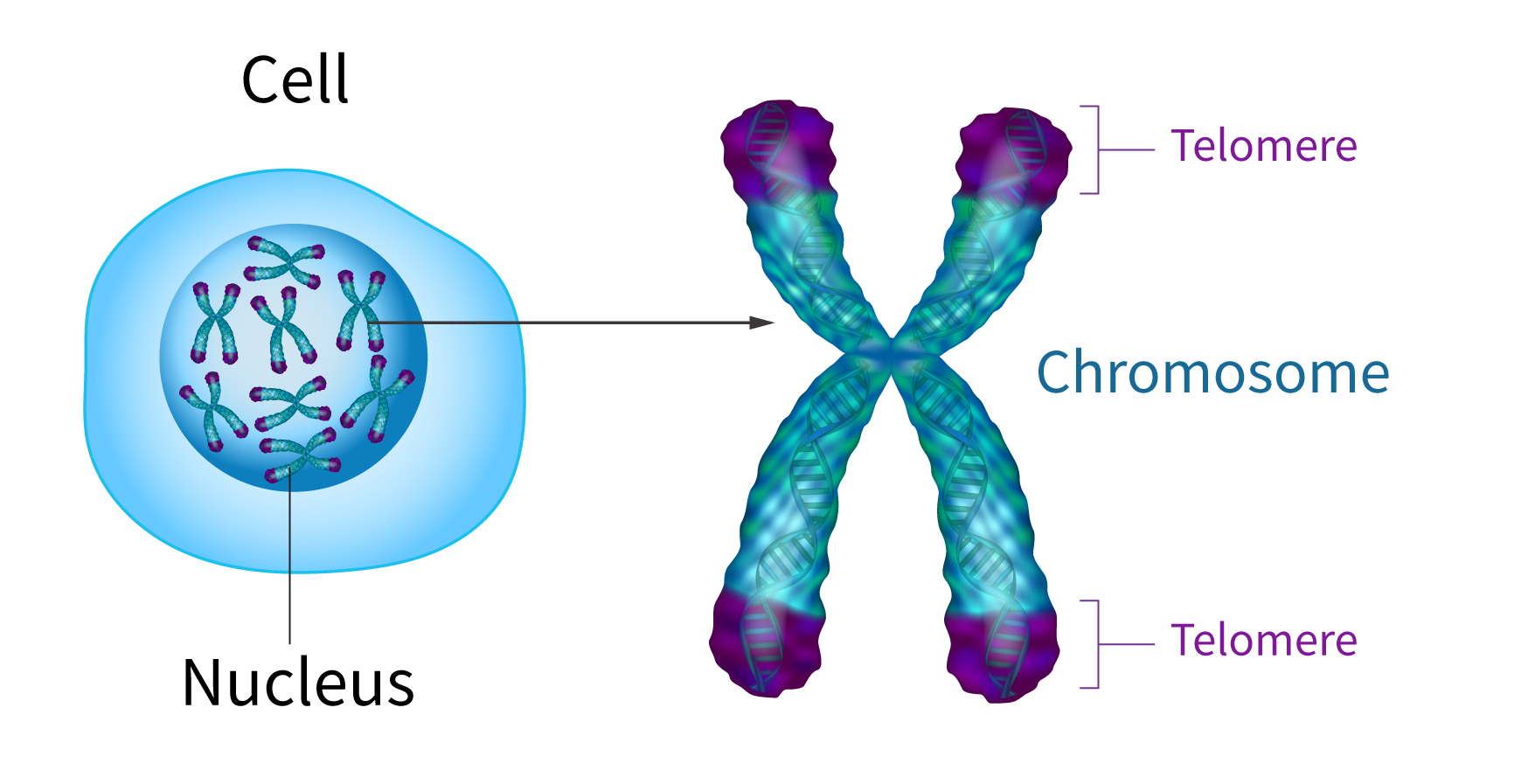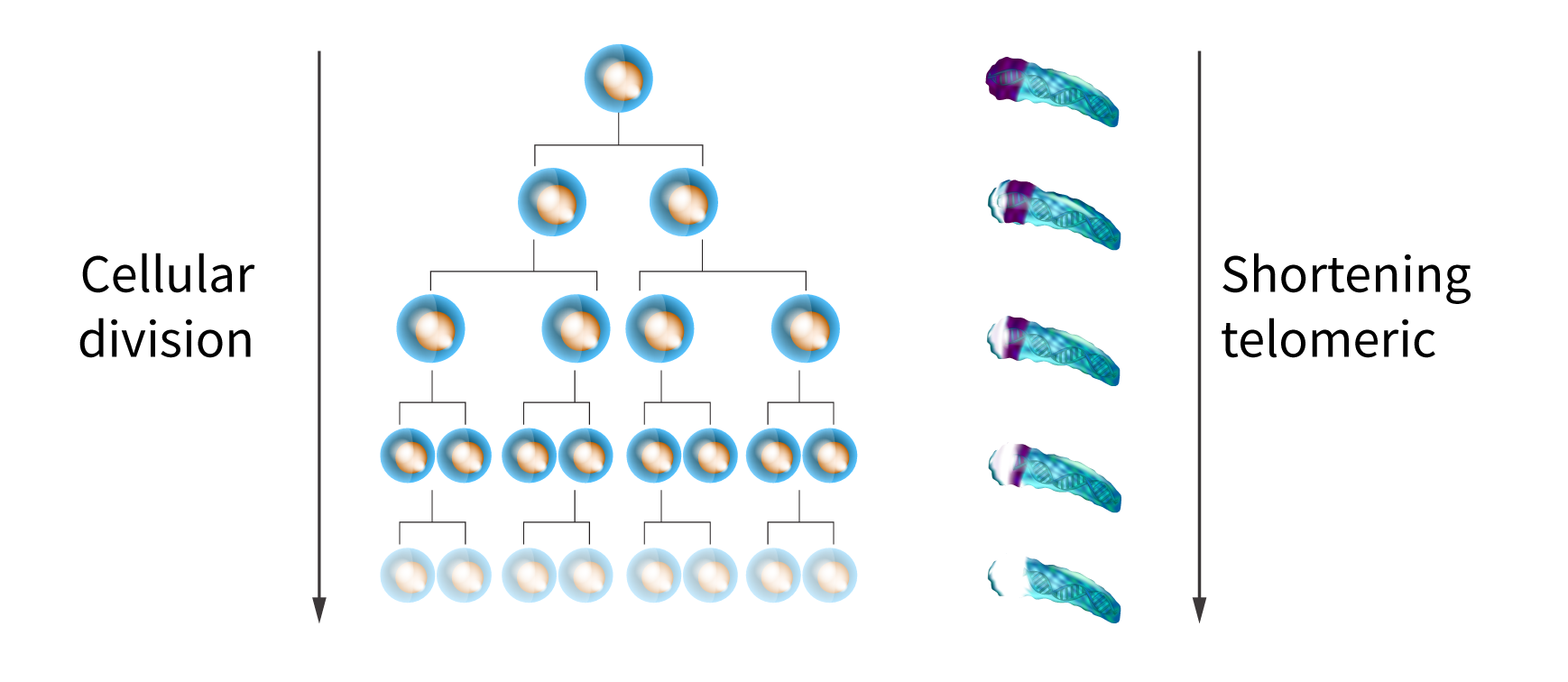Dra. Rosario Perona. Biomedical Researcher at the Institute for Biomedical Research (CSIC).
Telomeres, the protective tips of our chromosomes, are a kind of biologic clock. When we are born, we have some 12,000 base-pairs in these structures. As we age, we lose them, and they become progressively shorter. This process occurs in all tissues of the body, but is especially relevant in those most frequently renewed, such as the skin.
An enzymatic complex called the telomerase complex is in charge of repairing the telomeres. TERT proteins, dyskerin and RNA TR all play key roles in this complex. Nevertheless, the majority of cells in our bodies lose telomerase activity, except for germ and stem cells of the tissues that keep up their own regeneration. In many tissues, stem cells also progressively lose their telomerase activity, and with it, the capacity to keep up the renewal of the tissues. This is one of the main causes of ageing.

Peptide GSE4 is an internal sequence of dyskerin that has the capacity to partially revert the inhibition of the telomerase complex. The activity of this peptide has been studied using different models of healthy cells and cells derived from patients with compromised cellular processes, resulting in premature ageing. The diseases they suffer are due to the presence of mutations in genes that code proteins of the telomerase complex, or that are involved in other telomere repair and maintenance processes. Peptide GSE4 increases telomerase activity in cells in which it is diminished, as it augments the expression of the TERT gene, which is the sub-unit that cells lose in the ageing process.
As we age, in addition to the shortening of the telomeres, the cells of the body suffer certain alterations such as augmented genetic damage or an increase in the presence of reactive oxygen species; in other words, more oxidation. Other phenomena likewise observed in organisms include increased inflammatory processes during ageing, deficiencies in tissue repair, cell growth and connective tissue capacities.
We have discovered that the administration of peptide GSE4 reduces genetic damage as it increases cells’ capacity to repair this damage. Specifically, we have observed that GSE4 stimulates the genetic damage signalling pathways that make up the initial phase of DNA repair processes. As for oxidative damage, GSE4 increases the levels of cellular antioxidant enzymes such as superoxide dismutases 1 and 2, and catalase. The result of this is a reduction in the amount of reactive oxygen species that contribute to DNA oxidation and different molecules in the cells that could contribute to ageing of tissues. Furthermore, when facing stimuli that increase cell oxidation, GSE4 increases cells’ capacity to neutralize them.

During ageing, as a consequence of the increase in oxidative damage in cells, there is a greater secretion of the cytokines that cause inflammation, and activate the process of cell senescence, reducing cells’ capacity to divide and therefore repair tissues. We have seen that, thanks to its inhibiting effect on the oxidation process, GSE4 also reduces the secretion of pro-inflammatory cytokines, thus attenuating the inflammation associated with oxidative damage. Among the outcomes of the entire process are a reduction of cell senescence and an increase in DNA synthesis. It is all reflected in an increase in cells’ capacity to divide (mitosis) as well as an elongation of telomeres.
As a conclusion to all of these trials, it could be said that GSE4 has an anti-ageing effect because it can modify a number of cellular parameters at different levels. The various studies that we have conducted show that GSE4 acts on these pathways, having a synergistic effect, and with the net result of an increase in cellular survival facing a number of external insults, and therefore, a delay in tissue ageing. These beneficial effects can have an impact in health improvement of the aforementioned patients who present premature ageing. The organs of these patients, such as their lungs or bone marrow, can be severely affected. They also present relevant symptoms in epidermal tissues such as the skin or mucous membranes of the digestive tract. Further, this peptide can also be helpful in slowing down some of the physiological effects derived from the natural ageing of different tissues and organs that make up the human body.
GSE4 peptide suppresses oxidative and telomere deficiencies in ataxia telangiectasia patient cells. Pintado-Berninches L, Fernandez-Varas B, Benitez-Buelga C, Manguan-Garcia C, Serrano-Benitez A, Iarriccio L, Carrillo J, Guenechea G, Egusquiaguirre SP, Pedraz JL, Hernández RM, Igartua M, Arias-Salgado EG, Cortés-Ledesma F, Sastre L, Perona R. Cell Death Differ. 2019 Oct;26(10):1998-2014. doi: 10.1038/s41418-018-0272-7.
GSE4, a Small Dyskerin- and GSE24.2-Related Peptide, Induces Telomerase Activity, Cell Proliferation and Reduces DNA Damage, Oxidative Stress and Cell Senescence in Dyskerin Mutant Cells.
Iarriccio L, Manguán-García C, Pintado-Berninches L, Mancheño JM, Molina A, Perona R, Sastre L. PLoS One. 2015 Nov 16;10(11):e0142980. doi: 10.1371/journal.pone.0142980. eCollection 2015.
Perona R., Iarriccio L., Pintado-Berninches L., Rodriguez-Centeno J., Manguan-Garcia C., Garcia E., Lopez-Ayllón B., Sastre L. Molecular Diagnosis and Precision Therapeutic Approaches for Telomere Biology Disorders. In Telomeres a complex end of the chromosome. Ed. M. Larramendy and S. Soloneski. INTECH, ISBN 978-953-51-4609-4. P 77-117
At Luxfaciem Skin Renew we work tirelessly to understand the secrets of the skin and everything that keeps it healthy.
Because having healthy, young skin is a trait of beauty and well-being, a sign of living life to the fullest that shows on the outside.
Knowing your skin and its secrets will help you care for it. That is why, with input from professionals, we will be sharing key topics on skin and skin care in The Skin Blog.
